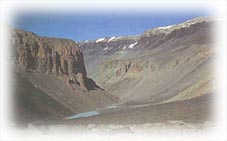|
  
|
 |
|
 Antarctic
Polar Regions | The Continent and its Islands Antarctic
Polar Regions | The Continent and its Islands
A taste of extra-terrestrial
On the 2% of land not covered by ice, in addition to the nunataks (rocky outcrops, crests or pieces of mountain, bare rock jutting out from the ice-cap), there are what the specialists call "dry valleys" or "oases", which are the most arid regions in the world. Situated close to the American base at McMurdo, in Wilkes Land and the Antarctic peninsula, these have been formed by erosion and the shrinking of glaciers.
They are the only places on the continent that manage to get rid of the snow that falls on the ground; first of all, because precipitation is rare here - it is often said that it has not rained for millions of years! - then, because when it does snow, the flakes are swept away by the violent winds that blow in the area (which come from the interior of the continent) and rapidly evaporate. 
The relief features in the area make you think of desert landscapes, almost extra-terrestrial; tortured mountains, bare rock, the ground covered in stones polished by the sand, like a desert of pebbles with grey-mauve sand, with almost no trace of life, apart from a few micro-invertebrates. Another special feature makes these dry valleys unique in the world: for a few weeks every year, the surrounding ice melts to produce water that forms real streams that can attain a maximum flow of 1 cu.m. per second, or turn into little fleeting lakes.
This melt water may also feed the larger lakes generally found in the lower reaches of the dry valleys. There, it is not unusual to find water indicating positive temperatures, under a coating of ice 4 to 5 metres thick.
At the bottom of Lake Vanda, for example, whi ch is 65 metres deep, the water temperatures reach 25°C on account of a complicated mechanism caused by the way the light falls and penetrates the layer of ice formed on the surface. The scientific value of these dry valleys is inestimable; they are the only places on the continent where researchers can observe ancient moraines best and try to figure out the mystery of the rocks that over time, have become incrusted in the very mass of the glaciers.
|

